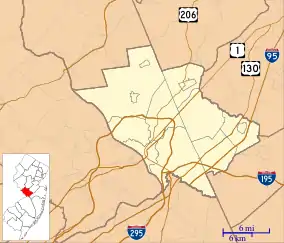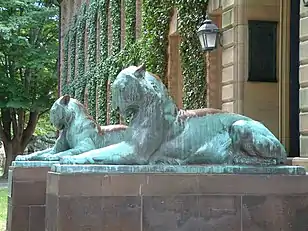Cannon Club
Cannon Club, also known as Cannon Dial Elm Club, is one of the historic Eating Clubs at Princeton University. Founded in 1895, it completed its current clubhouse in 1910. The club closed in the early 1970s and later merged with Dial Lodge and Elm Club to form Dial, Elm, Cannon (DEC), which closed its doors in 1998. In 2011 DEC reopened, now bearing the name Cannon Dial Elm Club, using its historic clubhouse, which had served as the home for the Office of Population Research during the club's hiatus.
Cannon Club | |
 | |
   | |
| Location | 21 Prospect Ave, Princeton, New Jersey |
|---|---|
| Coordinates | 40°20′52.1″N 74°39′12.1″W |
| Built | 1910 |
| Architect | Edgar Viguers Seeler |
| Architectural style | Collegiate Gothic |
| Part of | Princeton Historic District (ID75001143[1]) |
| Added to NRHP | 27 June 1975 |
History
Founding
The Eating Clubs play a central role in the history and life of Princeton University, serving as the primary place of dining and social life for more than 70% of upperclassmen.[2] Cannon Club was founded in 1895 and housed in a small house on William Street that had been home to Tiger Inn for the previous two years. From 1896-99 it was located in the "Incubator" a small house, at that time on Olden Street, that served as an early home to many of the Eating Clubs as they established themselves and sought to build clubhouses. In 1899, Cannon Club purchased the Osborn House that stood on the south side of Prospect Avenue, between the McCosh and West residences. That home fell into disrepair by 1908 and Edgar Viguers Seeler, a prominent Philadelphia architect, was commissioned to build a new clubhouse.[3] That Collegiate Gothic clubhouse, completed in 1910, was the first of the clubs to make use of local stone. While the facade has been described as plain in comparison with other clubs, the rear elevation and interiors have been praised, with the two-story living room considered one of the finest interior spaces found on Prospect.[4] The eponymous cannon sits in front of the clubhouse, pointed at Prospect Avenue. President-elect Woodrow Wilson, on a last stroll before departing for Washington, commented to reporters: "Hardly a chummy entrance that!"[5]
Demise
The club was famous for its debauchery, gaining a reputation as the Animal House of the university. One story from 1966 relates a nighttime coed nude volleyball game during Houseparties, the annual Princeton formal dance,[6] though the club's own history disputes that it was coed.[7] In the late 1960s the club gained a reputation for destructive behavior, including the destruction of a wall in neighboring Campus Club with sledgehammers, and the laceration of an artery of club president Michael Ryan while being passed down the stairs. The club also became involved in an incident of racial prejudice. In May 1969, one Cannon Club member loudly shouted the "N" word at a group of [African-American] students from the window of the "Rockefeller Suite" (a group of dorm rooms occupied by members of Cannon Club). That incitement led to the invasion of the largely unoccupied "Rockefeller Suite by a large group of [African American] students wielding knives, pipes and other weapons. Several couches and chairs were slashed and some other damage resulted. When retaliation was threatened by Cannon Club members, the University Administration became involved, holding an extended investigation into the entire affair. However, no Cannon Club members were expelled or suspended as a result, despite reports to the contrary .[8] The same year, an instructor's pregnant wife was accosted and held off the ground by a Cannon Club member on Prospect Street in front of the Club, however the identity of the Club member was never determined by the Administration. The notoriety and sanctions by the university led to a fall in membership, ultimately precipitating the closure of the club in the early 1970s.[9] The property came into the possession of the University, which spent 3/4 of a million dollars on renovations and deferred maintenance to turn the clubhouse into an academic building, Notestein Hall, which housed the Office of Population Research for over 30 years.[10]
Reopening
Despite the closure of the club, Cannon Club continued as a graduate board determined to continue the club's traditions and see it one day reopened. In 1989, Cannon merged with the financially imperiled Dial Lodge, and the combined entity was joined by Elm Club the following year. The stated goal of the new Dial Elm Cannon Club (DEC) was to exchange the Dial and Elm clubhouses for the old Cannon Club.[11] In 1997, an agreement was reached to exchange Dial and Elm for the Cannon clubhouse and $2 million. The club was unable to reopen Cannon at that time but retained the option to purchase the building.[12] This led to the second demise of the club with periodic claims that Cannon would reopen, a feat accomplished in 2011.[13] Today, the Club is again thriving and healthy.
References
- "Princeton Historic District". National Register of Historic Places. National Park Service.
- Hu, Winnie (July 29, 2007). "More Than a Meal Plan". The New York Times.
- "Cannon Club". An Interactive Campus History. Princeton University.
- Rhinehart, Raymond (March 1, 2000). Princeton University: The Campus Guide. Princeton Architectural Press. pp. 84–85. ISBN 978-1568982090.
- Maynard, William Barksdale (2012). Princeton: America's Campus. Penn State University Press. p. 115. ISBN 978-0271050867.
- Axtell, James (2006). The Making of Princeton University: From Woodrow Wilson to the Present. Princeton University Press. p. 369. ISBN 978-0691126869.
- "History". Cannon Dial Elm Club. Archived from the original on 2012-10-18. Retrieved 2015-07-16.
- Liemer, Ross (November 22, 2006). "The rise and fall of Cannon Club". The Daily Princetonian. Archived from the original on July 17, 2015. Retrieved July 16, 2015.
- Kleckner, Anthony S. (February 4, 1982). "Animal House of days past". The Daily Princetonian.
- "Report of the Committee on Undergraduate Residential Life". Princeton Weekly Bulletin. May 28, 1979.
- "Elm Merges with Dial and Cannon to Create "D.E.C."". Princeton Alumni Weekly. October 24, 1990.
- "University acquires Prospect St. properties". Princeton Weekly Bulletin. September 21, 1998.
- Zumbach, Laure. "Cannon To Join Most Selective Clubs – If It Ever Opens". The Ink. University Press Club.
